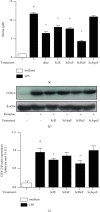Anti-Inflammatory Activity and Chemical Analysis of Different Fractions from Solidago chilensis Inflorescence
- PMID: 34745422
- PMCID: PMC8570869
- DOI: 10.1155/2021/7612380
Anti-Inflammatory Activity and Chemical Analysis of Different Fractions from Solidago chilensis Inflorescence
Abstract
Solidago chilensis Meyen (Compositae) is a species native to South America (Brazil) popularly known as arnica. In Brazilian popular medicine, inflorescences and rhizomes of this plant have been used since the end of the 19th century to replace the exogenous and hepatotoxic Arnica montana L. in the treatment of edema and inflammatory pathologies. Although the anti-inflammatory activity of S. chilensis is evidenced in the literature, there is a lack of studies with enriched fractions or compounds isolated from it. The objective of the current study was to characterize phytochemically and to evaluate the pharmacological action in vivo and in vitro of the crude extract and the different fractions (hexane, dichloromethane, acetal, butanolic, and aqueous) isolated from the inflorescence of S. chilensis. The inflorescence crude extract (ScIE) and fractions were administered by intraperitoneal route to mice at different doses. In an LPS-induced pleurisy model, inhibition of leukocyte influx was observed for the ScIE and all fractions tested, as compared to controls. Dichloromethane (ScDicF), butanolic (ScButF), and aqueous (ScAquF) were selected for further analysis as they showed the best inhibitory effects in leukocyte migration and inflammatory cytokine and chemokine production: TNF-α, CXCL1/KC, CXCL2/MIP-2, and CCL11/eotaxin-1. In LPS-stimulated J774A.1 cell line, ScIE and the ScDicF exhibited an inhibitory effect on nitric oxide (NO) production and downmodulated the COX-2 expression; ScAquF failed to modulate NO production and COX-2 expression. In phytochemical analysis, HPLC-UV-DAD chromatograms of ScDicF and ScAquF showed the main peaks with UV spectrum characteristics of flavonoids; chlorogenic acid and isoquercetin were the most present phytochemicals identified in the ScAquF, and a high number of n-alkanes was found in ScHexF. Our study was the first to address biological effects and correlate them to phytochemically characterized fractions from inflorescences of S. chilensis.
Copyright © 2021 Thais Morais de Brito et al.
Conflict of interest statement
The authors declare no conflict of interest.
Figures






References
-
- de Barros M., Mota da Silva L., Boeing T., et al. Pharmacological reports about gastroprotective effects of methanolic extract from leaves of Solidago chilensis (Brazilian arnica) and its components quercitrin and afzelin in rodents. Naunyn Schmiedebergs Arch Pharmacology . 2016;389(4):403–417. doi: 10.1007/s00210-015-1208-0. - DOI - PubMed
-
- Pio Corrêa M. “Dicionário de plantas úteis do Brasil e das exóticas cultivadas”, Rio de Janeiro: Ministério da Agricultura. IBDF . 1984;6:p. 777.
-
- Mors W., Rizzini C., Pereira N. Medicinal plants of Brazil . Algonac: Reference Publications; 2000.
-
- Facury Neto M., Fagundes D., Beletti M., Novo N., Juliano Y., Penha-silva N. Systematic use of Solidago microglossa dc in the cicatrization of open cutaneous wounds in rats. Brazilian Journal of Morphological Sciences . 2004;21(4):207–210.
MeSH terms
Substances
LinkOut - more resources
Full Text Sources
Research Materials

